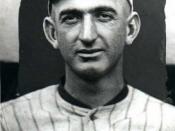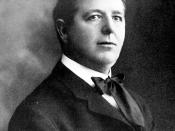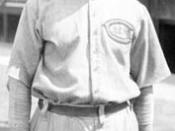Imagine your fate and future resting in the hands of one man's judgment. This was actually reality for Shoeless Joe Jackson. Many argue that he was one of the best ever to play the game of baseball and was the greatest natural hitter of all-time. Yet, surprisingly, you will not find him among the familiar faces at the Hall of Fame. He was permanently banned from baseball, as well as seven others, for allegedly helping to throw the 1919 World Series.
Joe Jackson was born on July 16, 1888 in Pickins County, South Carolina. He was the oldest of eight children and grew up the son of a cotton mill worker. He began working in the mill at age thirteen and never learned how to read or write. He played baseball in his spare time, and his exceptional skills landed him in the minor leagues by the age of eighteen.
He first entered professional baseball in 1908 with Greenville in the Carolina Association. It was during this same year that he received the nickname "Shoeless" Joe after he had just bought a new pair of spikes. They wore blisters on his feet and they hurt so badly that he just played in his stocking feet. Although he played only one game without the spikes, he was known as "Shoeless Joe" from then on (McGee 1).
Shoeless Joe made his major league debut later that year, in 1908, with the Philadelphia Athletics. He only played there a short time before being transferred to the Cleveland Indians. Finally, in 1915 he was sold to Charles Comiskey and the Chicago White Sox. It was here that he played his last few years of professional baseball and his life would be forever changed. From the years 1917 to 1919 the Chicago White Sox were by far the dominant team in baseball. It is speculated that they could have "gone on to become one of the greatest teams in history" (Schwalbe 2). However, despite having the most talented team around, Charles Comiskey paid his players considerably less than any other winning team (Durst 2). Due to the oppression they were under, the player's morale began to decrease as their need for money increased. They considered going on strike, but were talked out of it by their manager, "Kid" Gleason. They remained desperate until first baseman Chick Gandil met with a notorious gambler named "Sport" Sullivan.
The White Sox were far ahead in the standings and were headed to the World Series against the Cincinnati Reds. Gandil told Sullivan that he knew the Series could be fixed, especially due to the present conditions. He wanted $80,000, which Sullivan agreed to. Gandil had difficulties at first, but he ostensibly persuaded teammates Eddie Cicotte, Claude "Lefty" Williams, Buck Weaver, Fred McMullen, "Happy" Felsch, Swede Risberg, and Joe Jackson into joining him in the fix (Schwalbe 4). The scandal began to rise to great proportions as the rumors began to spread. One of the biggest professional gamblers became involved, Arnold Rothstein, as well as gamblers "Sleepy Bill" Burns and Billy Maharg. Other gamblers started laying down unusual bets, as the greed for money heightened. Comiskey and Gleason heard the rumors of the fix, but refused to believe them (Schwalbe 6).
Slowly, signs began to show that something was not right. In a best-of-nine series, the White Sox lost the first, second, fourth, fifth, and eighth games. The World Series Championship went to the Reds and left Comiskey furious. He supposedly said the involved players would never play for him again. Nevertheless, the 1920 season went under way, and the White Sox were in hot contention for the pennant and had record profits at the box office. Finally, in September of 1920, a Cook County grand jury looked into allegations that the 1919 World Series had been thrown. Cicotte was called into court and was the first to admit to the scandal, followed by Shoeless Joe. Illinois had no law about fixing games, and the eight players were acquitted of the charges brought against them for defrauding the public and injuring the business of Charles Comiskey and the American League (Schwalbe 9).
The owners of baseball needed desperately to shake this horrible scandal that crushed the integrity of the game. They appointed Kennesaw Mountain Landis as commissioner, and the day after the eight were acquitted, he barred them from baseball for life. While there is no doubt that a scandal occurred, it is often questioned who was directly involved and whether or not Landis's actions were justifiable. The most questionable player often mentioned is Shoeless Joe. There is no solid evidence to back up the charge that he was involved in the fix (Nola 1). While under oath, Sleepy Bill Burns, the fixer who put the players and gamblers in touch with each other, testified that he never talked to Joe about the fix. Instead, he took the word of Lefty Williams. While also under oath, Williams admitted he never received permission from Joe to use his name with the fixers. There is actually some evidence that has lead people to believe that Joe tried to tell one or more White Sox officials about the fix, before the start of the 1919 World Series. Joe even allegedly told Comiskey and asked to be benched for the Series to avoid any suspicion that he was involved, but his request was refused. Joe ended up being one of the stars of the Series. He hit the only homerun, led all players by batting .375, fielded flawlessly, and his twelve hits set a World Series record (Nola 1). On the evening after the last game, Lefty Williams came to his hotel room and offered him an envelope of cash. Joe refused the money and left the room, but Williams left it there. Joe tried to take the envelope containing $5,000 to Comiskey the next morning, but was told Comiskey was too busy to see him. Comiskey knew of the fix before it happened and was now trying to cover it up and protect his own reputation. Comiskey's lawyer acted as Joe's lawyer also, although he was really only trying to protect Comiskey.
In modern day, Joe would have had his own lawyer from the beginning and Landis would have been convicted of contempt of court since he went against the court's ruling and banished the eight players for life. Joe would not have had to prove his innocence. Instead, someone would have had to prove him guilty. Clearly, this could not have been achieved. There is no evidence that he did anything wrong, and his statistics clearly support the opposite. Alongside, his performance in the 1919 World Series, Joe's career batting average of .356 is the third best of all-time (CMG 1). On top of this, he led the league in triples eight times and held the throwing record for distance. It is a shame he was never inducted into the Hall of Fame because of one man's judgment to ban him from the game. Part of Joe's last words were "I'm going to meet the greatest umpire of all - and he knows I'm innocent." (McCroskey 1). He passed away on December 5, 1951, and will remain, although often disparaged and misunderstood, one of our national pastime's greatest legends.
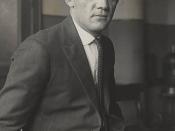
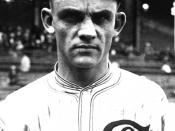
![English: Photo courtesy of the Boston Public Library. Charles Comiskey, owner of the Chicago White Sox. Photo caption: The Old Roman, Comisky [sic], owner of the Chicago Americans.; McGreevey no. 5](https://s.writework.com/uploads/1/12343/english-photo-courtesy-boston-public-library-charles-comiske-thumb.jpg)
